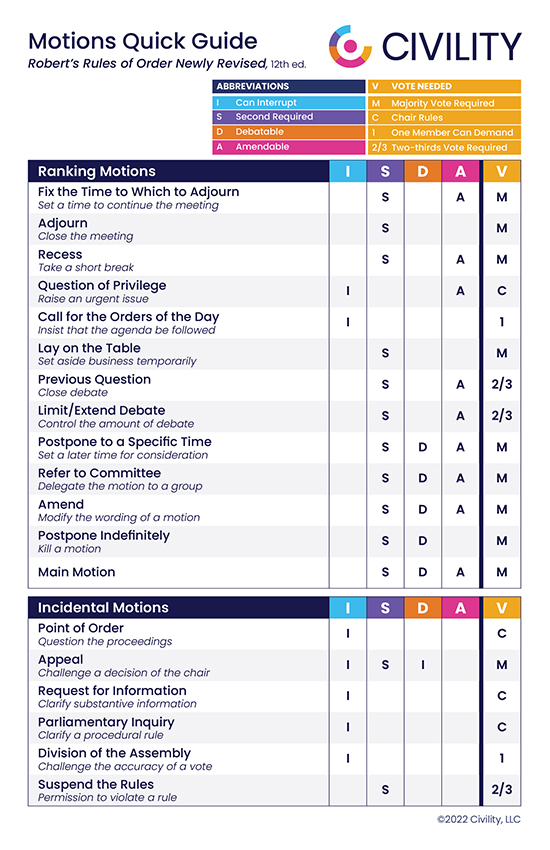A motion is a proposal that an organization, board, or committee take a specific action (according to Robert’s Rules of Order and other parliamentary procedure authorities). And of course, with any good term, there are subcategories: main motions and secondary motions.
Main motions propose substantive action. For example, a main motion might propose that a group purchase land, organize a fundraiser, or hire more staff. Virtually any proposal related to the objectives of the group qualifies as a main motion.
Secondary motions propose procedural action. They relate to the operation of a group’s meetings. For example, proposals to limit debate, table a main motion, refer a main motion to a committee, or adjourn – all of these are secondary motions under the rules.
Main motions and secondary motions work together – as members propose them – to maintain order and propel a meeting from start to finish.
Next, here’s how to propose a motion.
During a meeting, a motion is made via three simple words: “I move that.” Any member with a proposal for the group to consider – whether substantive or procedural – should simply seek recognition by the chairperson and when recognized, say, “I move that . . . .”
Again, there are subcategories. If the motion is a substantive proposal (a main motion), a member could say, for example, “I move that we organize an event in March to raise awareness and funds for our capital campaign.” There’s one important rule of motion-making, though: A main motion can be made only when no other main motion is being considered by the group. Don’t interrupt the business at hand with other business.
If the motion is a procedural proposal (a secondary motion), a member could say, “I move that we refer the main motion regarding a fundraiser to the Fundraising and Development Committee.” Unlike a main motion, though, a secondary motion can be made even while the group is in the middle of another motion.
Wrapping things up: What happens to the motion?
Once a motion is made, another member must “second” the motion before the group is required to consider it. A second is simply an indication by another member that the motion just made is worthy of the group’s time.
Once another member “seconds” the motion, the chairperson repeats it back to the group, indicating that the idea as proposed is available for consideration by the group. Consideration could include debate, referral of the proposal to a committee, or postponed consideration until a later meeting. Regardless, the group should eventually take some action (even if it’s adjourning the meeting) that will permanently or temporarily dispose of the motion.
Where to Learn More


